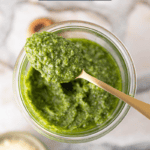Pesto alla Genovese Recipe (Authentic Basil Pesto)
My Pesto alla Genovese recipe is an authentic, herbaceous pesto sauce full of fresh basil. And this Genovese pesto is a classic Italian basil pesto made with simple, natural ingredients. What sets my pesto recipe apart is the perfect balance of the ingredients—you enjoy the pure taste of the ingredients without anything too overpowering. And the best part about this recipe? It uses all raw ingredients—no cooking required! Plus, this is a great way to use leftover basil at the end of the week.
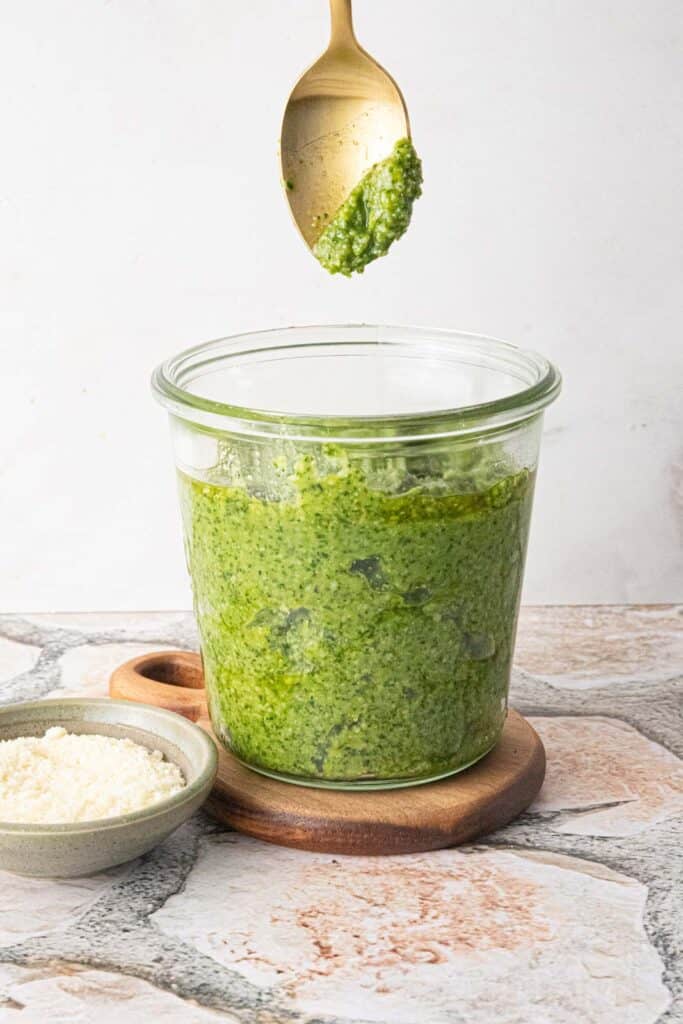
This classic recipe always reminds me of our trip to Cinque Terre! There, we learned how to make the pesto using a marble mortar and pestle. I even bought one while we were there and lugged it all the way home! We ate a ton of pesto pasta on this trip, so I wanted to make an easy pesto recipe that anyone could make at home, even without a mortar!
This, along with my other Italian recipes, is my love letter to Italy. Check out my trofie pasta al pesto if you enjoy this classic basil pesto. If you love Italian dishes, check out my Carbonara, Bolognese, Focaccia, or Cacio e Pepe Risotto!
Table of contents
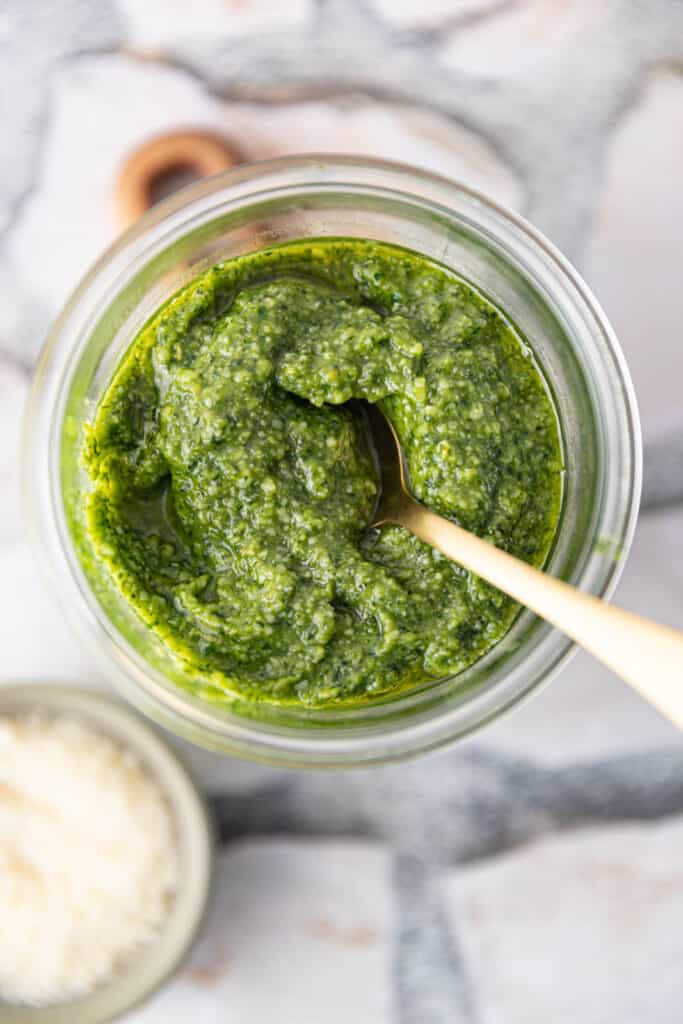
Why You’ll Love This Recipe
- Health benefits – Indulgence meets nutrition in my Pesto alla Genovese recipe. Made with wholesome ingredients like fresh basil, heart-healthy olive oil, and protein-packed pine nuts, this sauce is not only a treat for the taste buds but also a nourishing addition to any meal. With its vibrant green hue and flavors, it’s a guilt-free pleasure you can enjoy without hesitation.
- Authenticity – My Ligurian pesto recipe brings the true taste of Italy right into your kitchen. Crafted with the finest ingredients and traditional techniques, this recipe stays true to its Genoese roots, ensuring an authentic culinary experience that transports you to the sun-drenched shores of Liguria with every bite.
What Does Pesto Taste Like?
Pesto has a distinct and vibrant flavor profile. Genovese pesto has a fresh, herbaceous taste with notes of basil, along with the nuttiness of pine nuts, the sharpness of garlic, and the richness of olive oil. Adding hard cheeses, typically Parmesan or Pecorino, adds a savory and slightly salty element to the sauce. Overall, pesto offers a balanced combination of flavors that is both bright and satisfying.
Ingredients
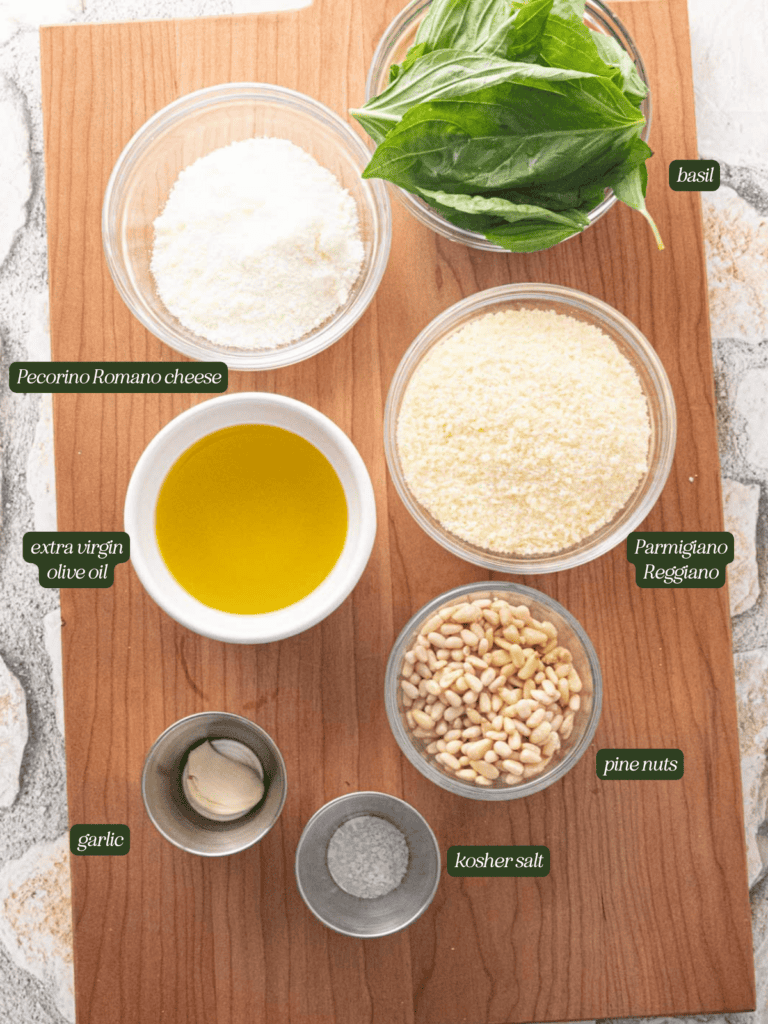
- Basil – Pesto is known for big, bright green color from fresh basil leaves. And this is the main ingredient, too!
- Pine nuts – These pine nuts contribute a creamy texture and nutty taste, adding richness and depth to the sauce.
- Garlic – A single garlic clove infuses the pesto with its pungent aroma and robust flavor. There is such a thing as too much garlic for pesto – trust me, just use one clove.
- Pecorino Romano cheese – Pecorino cheese is a sheep’s milk cheese that lends a sharp and tangy bite to the pesto, balancing out the other ingredients with its salty notes.
- Parmigiano Reggiano cheese – Parmigiano Reggiano cheese adds a nutty and savory element to the pesto, enhancing its umami profile and providing a creamy texture.
- Extra virgin olive oil – Extra virgin olive oil binds the ingredients together while imparting a fruity and peppery flavor that complements the freshness of the basil.
Substitutions
- Basil – If you don’t have fresh basil, you can substitute it with other leafy greens such as spinach, arugula, or kale. Each will impart a slightly different flavor profile to the pesto.
- Pine nuts – Pine nuts can be quite expensive and may not always be readily available. You can substitute them with other nuts like walnuts, almonds, or even cashews, adding a similar creamy texture and nutty flavor to the pesto.
Instructions for Pesto alla Genovese
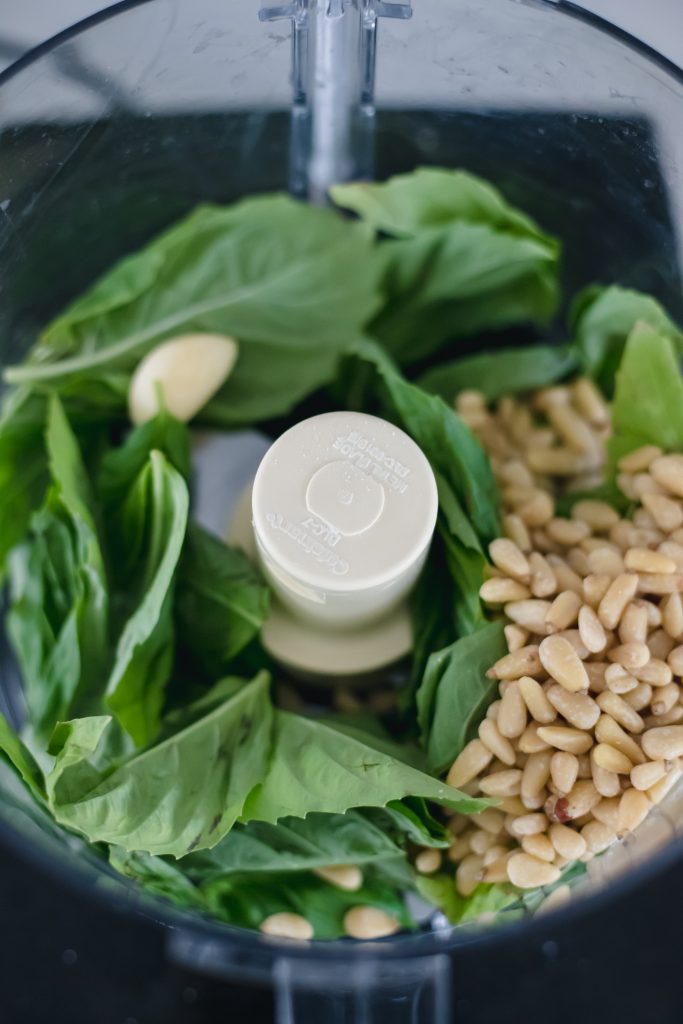
Step 1: First, add fresh basil leaves, pine nuts, garlic, and a pinch of salt to the bowl of a food processor fitted with the blade attachment.
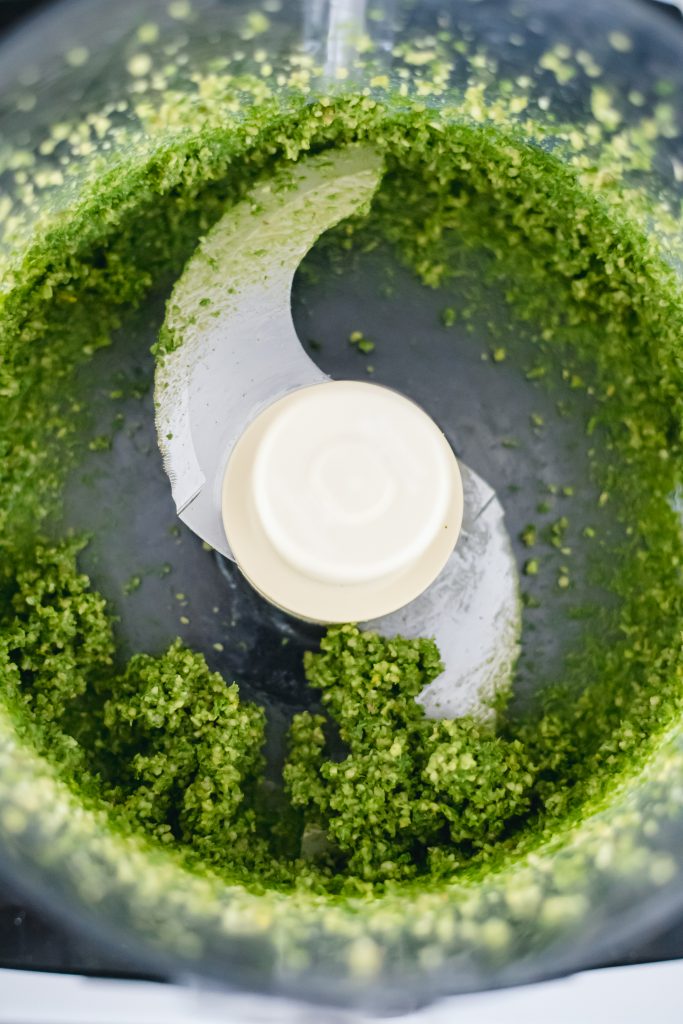
Step 2: Pulse the ingredients until the basil leaves are finely chopped and all the ingredients are well combined.
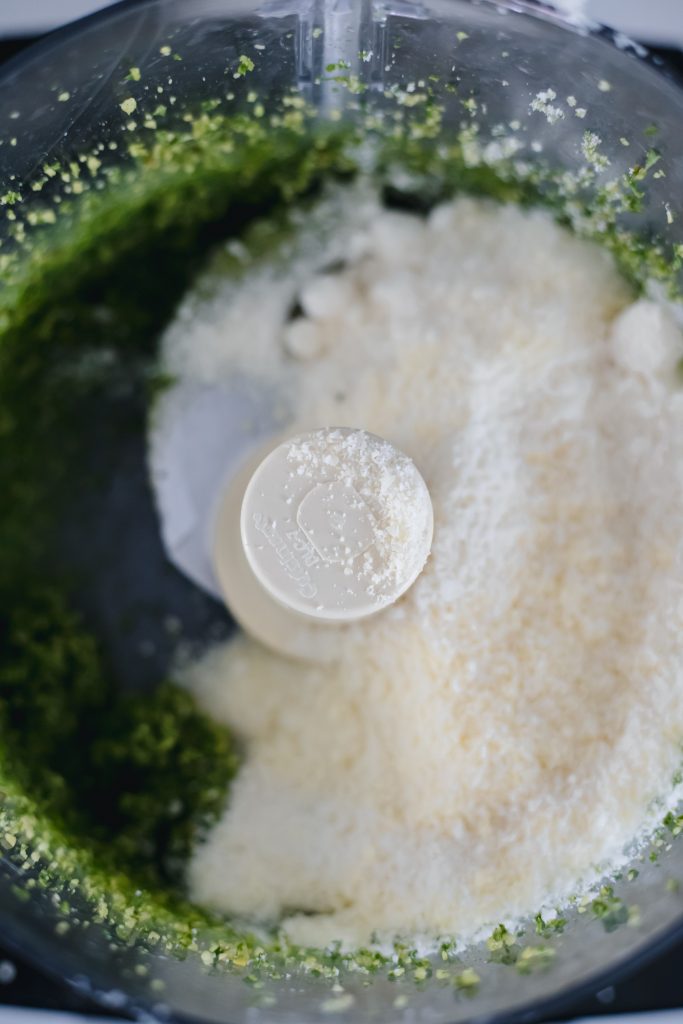
Step 3: Next, incorporate the two cheeses into the mixture and pulse again until everything is evenly distributed.
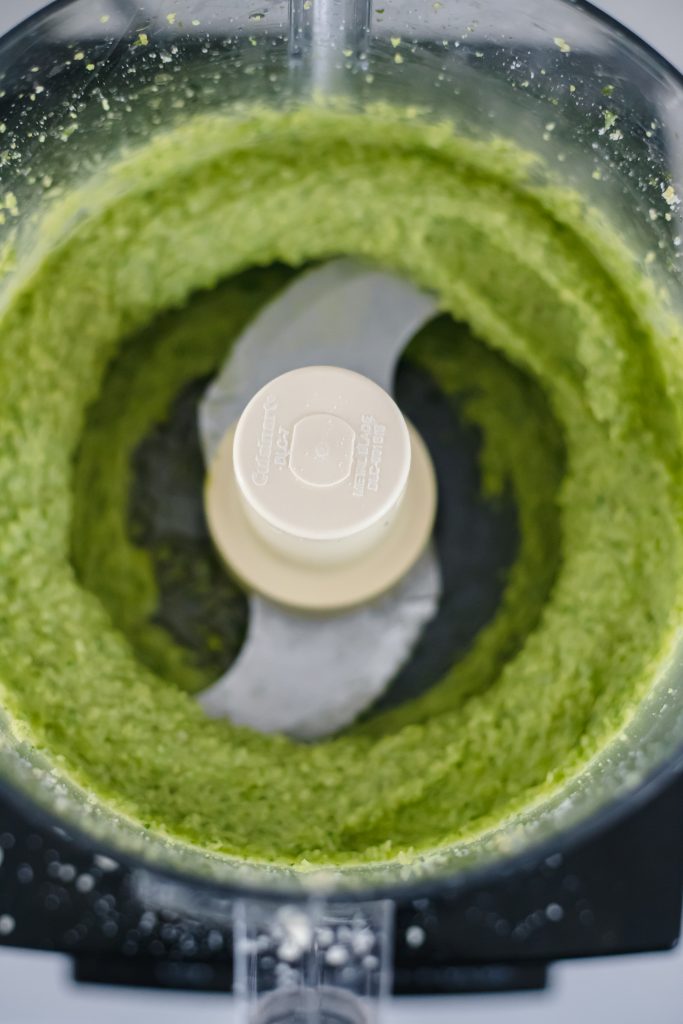
Step 4: With the food processor running, slowly pour in the olive oil in a steady stream. Continue to process until the sauce reaches a smooth and creamy consistency.
Tips and Notes
- Freshness is key – Use the freshest ingredients possible for the best flavor. So this means using vibrant green basil leaves, recently purchased nuts, and freshly grated cheese.
- Adjust consistency – If your pesto turns out too thick, you can thin it out with a little bit more olive oil until you reach your desired consistency. Conversely, if it’s too runny, you can add more nuts or cheese to thicken it up.
Is Pesto Gluten Free?
Pesto is typically gluten-free. The main ingredients in traditional pesto – basil, pine nuts, garlic, olive oil, and cheese – are naturally gluten-free. However, it’s always important to double-check the specific ingredients you’re using, especially if you’re using store-bought items like pre-grated cheese or pre-made pesto sauce, as they may contain additives or thickeners that could contain gluten. So, while homemade pesto made with fresh ingredients is generally safe for those with gluten sensitivities or celiac disease, it’s always a good idea to read labels carefully and choose certified gluten-free products.
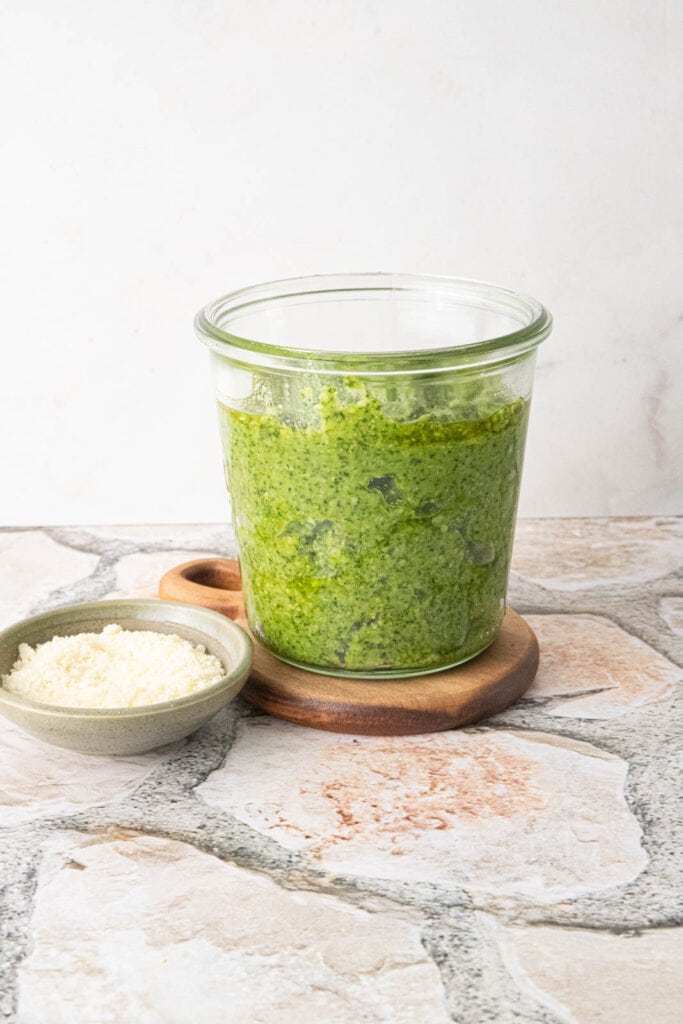
Is Pesto Vegetarian?
Traditional basil pesto is not vegetarian because it typically contains cheeses made with animal rennet. Parmesan cheese, a common ingredient in traditional pesto, is made with animal rennet. In fact, according to European Union regulations, Parmigiano-Reggiano must include animal rennet in its production to be labeled as such. However, it’s possible to create vegetarian pesto using cheese substitutes such as tofu or nutritional yeast.
Serving Suggestions
- Pasta – Toss cooked pasta (such as spaghetti, linguine, or any type of pasta) with a generous dollop of pesto for a simple and satisfying meal. Don’t forget to cook your pasta al dente and to salt your pasta water!
- Bruschetta – Spread pesto on toasted slices of crusty bread and top with cherry tomatoes, fresh mozzarella, and a drizzle of balsamic glaze for a delicious appetizer or snack. Next, you have to try my Pesto Bruschetta recipe!
- Grilled chicken or fish – Use pesto as a marinade for grilled chicken breasts or fish fillets. Simply coat the protein with pesto and let it marinate for 30 minutes before grilling. The pesto adds flavor and helps keep the meat or fish moist and tender.
- Caprese salad – Make a traditional country Caprese salad with sliced tomatoes, fresh mozzarella, and basil leaves. Drizzle pesto over the top for a flavorful twist on this Italian favorite.
- Pizza – Spread pesto on homemade or store-bought pizza dough as a flavorful alternative to tomato sauce. Top with your favorite toppings such as grilled vegetables, chicken, or prosciutto for a gourmet pizza night!
- Pesto dip – Serve pesto for breadsticks, crackers, or raw vegetables. It’s perfect for entertaining and a great addition to any appetizer spread.
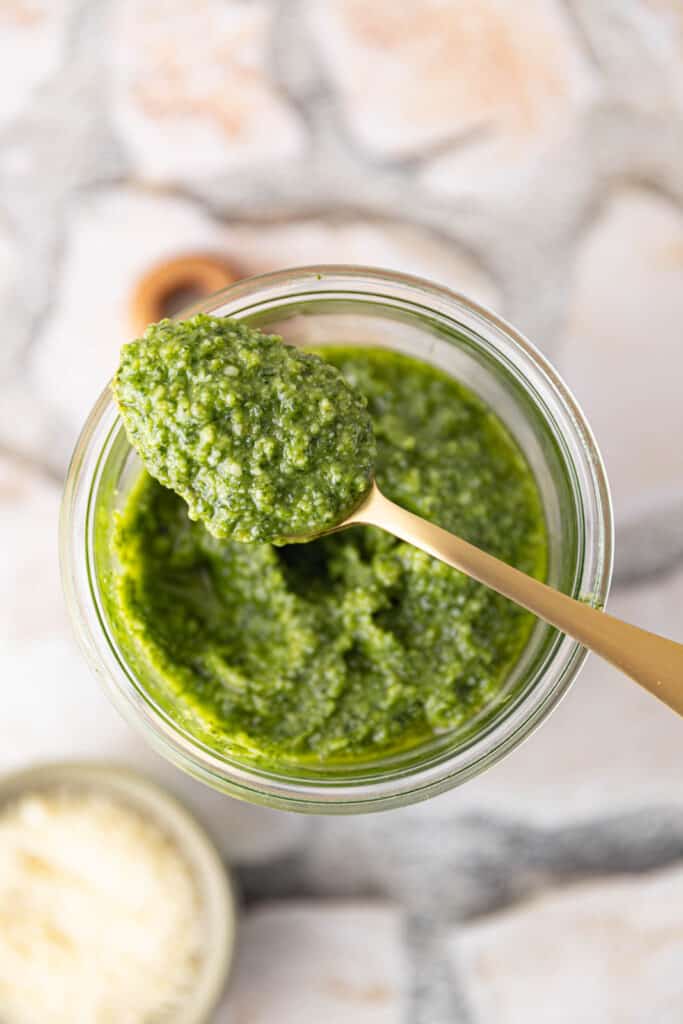
How Long Does Pesto Last in the Fridge?
- Store homemade or store-bought pesto in an airtight container in the refrigerator. Make sure the pesto is fully covered with a thin layer of olive oil to prevent oxidation and maintain its vibrant green color.
- Use within a week. Pesto can typically be stored in the refrigerator for up to a week. However, it’s best to consume it within a few days for optimal freshness and flavor.
How to Freeze Basil Pesto Sauce
- Portion the pesto – Fill ice cube trays with pesto, leaving space for expansion.
- Freeze – Place trays in the freezer for 4-6 hours or overnight.
- Transfer to bags – Remove frozen pesto cubes, place in labeled freezer bags, remove excess air, and seal tightly.
- Store – Store bags in the freezer for up to 4-6 months.
- Thaw and use – To use, thaw desired number of cubes in the refrigerator overnight or at room temperature, or quickly in the microwave using the defrost setting.
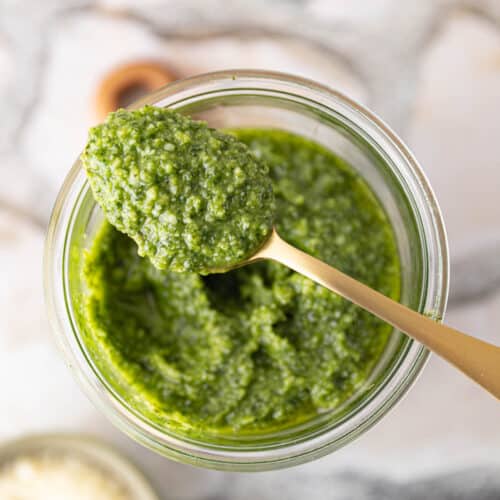
Pesto alla Genovese Recipe (Authentic Basil Pesto)
Equipment
- measuring spoons
- measuring cups
- food processor
Ingredients
- 1 cup basil *packed cup* 36 g
- 1/2 cup pine nuts 75 g
- 1 clove garlic peeled
- 1 cup freshly grated parmesan cheese 126 g
- 1/2 cup freshly grated pecorino romano cheese 50 g
- 7 tablespoons extra virgin olive oil 74 g
- 1/4 teaspoon kosher salt
Instructions
- Start by adding fresh basil leaves, pine nuts, garlic, and a pinch of salt to the bowl of a food processor fitted with the blade attachment.
- Pulse the ingredients until the basil leaves are finely chopped and all the ingredients are well combined.
- Next, incorporate the two cheeses into the mixture and pulse again until everything is evenly distributed.
- With the food processor running, slowly pour in the olive oil in a steady stream.
- Continue to process until the sauce reaches a smooth and creamy consistency.
- Don’t forget to taste the pesto and adjust the seasoning if needed, adding a bit more salt or pepper to suit your taste preferences.
Notes
Nutrition
Enjoy, and as always, please let me know if you make this recipe – and if you do, don’t forget to tag @seasonedandsalted and #seasonedandsalted on Instagram!

